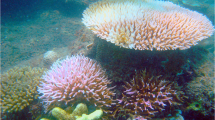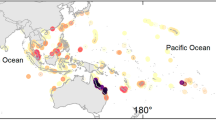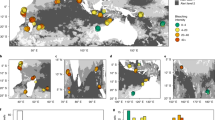Abstract
The highest sea surface temperatures ever recorded, related both to the 1997–98 El Niño/Southern Oscillation and to global warming1, caused severe bleaching of corals worldwide in 1998 (ref. 2). This thermal anomaly induced mass mortality of scleractinian corals on lagoonal reefs in Belize, the first time that a coral population in the Caribbean has collapsed completely from bleaching. Cores extracted from the Belizean reefs showed that these events were unprecedented over at least the past 3,000 years.
Similar content being viewed by others
Main
Coral bleaching occurs when coral colonies under physiological stress expel their symbiotic algae (zooxanthellae). Usually a response to high temperature and/or high incident solar radiation, bleaching has become more frequent on coral reefs worldwide over the past two decades3,4. Bleaching-related mass coral mortalities, involving population collapses that can lead to local extirpation, have occurred several times recently in the Indo-Pacific5,6. In contrast, bleaching in the Caribbean has until now been followed by substantial recovery of the affected coral populations7.
There are no records of mass bleaching along the Belizean barrier reef before an episode in 1995, from which most coral colonies recovered8. In 1998, sea temperatures in the central sector of the barrier reef, which rarely exceed 29 °C, were greater than 30 °C (maximum, 31.5 °C) at depths of 2 and 10 m from 10 August to 14 October (K. H. Koltes, personal communication). Storm waves and rain associated with hurricane Mitch (27–31 October) reduced temperatures by 1 °C or less, but temperatures did not drop below 29 °C until 6 November. Mass bleaching was evident in both fore-reef and lagoonal environments during the summer and autumn (T. Bright, personal communication). Some coral colonies on the fore reef experienced partial mortality, but most colonies recovered their coloration in the months following hurricane Mitch9. In contrast, levels of coral mortality were catastrophic in the lagoon.
The lettuce coral Agaricia tenuifolia was the most abundant coral on reefs of the central Belizean lagoon in 1998 (Fig. 1). Surveys at two sites on 22–23 October showed that virtually all living coral colonies were bleached white. Some of the bleached Ag. tenuifolia had already died by late October (Fig. 1b); the dead skeletons were standing in their growth position, indicative of recent mortality. Complete bleaching was also evident in almost all large, plate- and head-forming species down to the lagoon floor at 21 m. Surveys in 1999 and 2000 revealed that Ag. tenuifolia had undergone almost total mortality at all depths. Heavy mortality occurred in the other species as well (Fig. 1a). Similar patterns were seen throughout a 375-km2 area of the central lagoon. High water turbidity and the broad depth range of these effects suggest that temperature, rather than solar radiation, was primarily responsible for the bleaching and subsequent coral mortality.
a, Changes at Channel Cay, and b, at Cat Cay, which is 4 km away (∼16° 40′ N, 88° 10′ W). Error bars represent standard errors. Asterisks indicate the onset of the high-temperature anomaly in August 1998. Percentage cover was estimated by laying a measuring tape down the reef slope along permanent transects and recording the sessile organisms every 10 cm. Hard corals include Scleractinia (true corals) and Milleporina (fire corals); the latter always constituted much less than 1% cover. Transects were about 20 m long and spanned 3–15 m depth at Channel Cay (n = 3); transects were about 8 m long and spanned 3–8 m depth at Cat Cay (n = 5). Surveys were made in December 1996, August 1997, October 1998, in January, March, June and October 1999, and in February 2000. Virtually all living colonies in October 1998 were completely bleached. The subsequent decline in coral cover was significant at P = 0.004 (sign test).
Ag. tenuifolia had been the dominant space-occupier on lagoonal reefs since the late 1980s. At that time, the previous dominant, Acropora cervicornis (staghorn coral), was almost eliminated by white-band disease (a presumed bacterial infection unrelated to bleaching), permitting Ag. tenuifolia to increase opportunistically10. To determine whether similar events occurred in the past, we extracted 12 cores by hand from nine reefs in the central lagoon.
These push-cores penetrated several metres into the uncemented reef frameworks. Radiocarbon analysis yielded a maximum uncorrected 14C date of more than 3,000 yr. The cores showed continuous domination of lagoonal assemblages by Ac. cervicornis, with no widespread Acropora mortality, and no replacement by and subsequent disappearance of Ag. tenuifolia , in the three millennia before the late 1980s. The loss of Ac. cervicornis to disease, its replacement by Ag. tenuifolia, and the loss of Agaricia to bleaching a decade later were novel events on a timescale of millennia, and they occurred following an extended period of stable sea level (a sea-level rise of about 1 m in the past 3,000 yr)10,11.
There is growing concern that global climate change is degrading coral reef ecosystems12,13, with coral mortality increasing as a result of bleaching and emergent diseases4,12,14: our results from Belize appear to justify this concern.
References
Hansen, J. et al. J. Geophys. Res. 104, 30997– 31022 (1999).
International Society for Reef Studies Reef Encounter 24, 19–20 ( 1998).
Glynn, P. W. Coral Reefs 12, 1–17 ( 1993).
Hoegh-Guldberg, O. Mar. Freshwat. Res. 50, 839–866 (1999).
Glynn, P. W. in Global Ecological Consequences of the 1982–83 El Niño-Southern Oscillation (ed. Glynn, P. W.) 55–126 (Elsevier, Amsterdam, 1990).
Oliver, J. Proc. 5th Int. Coral Reef Congr. 4, 201– 206 (1985).
Porter, J. W. et al. Proc. Natl Acad. Sci. USA 86, 9342– 9346 (1989).
McField, M. D. Bull. Mar. Sci. 64, 155–172 (1999).
Mumby, P. J. Mar. Ecol. Prog. Ser. 190, 27–35 (1999).
Aronson, R. B. & Precht, W. F. Paleobiology 23, 326–346 ( 1997).
Macintyre, I. G. et al. Atoll Res. Bull. 430, 1– 18 (1995).
Smith, S. V. & Buddemeier, R. W. Annu. Rev. Ecol. Syst. 23, 89–118 (1992).
Kleypas, J. A. et al. Science 284, 118–120 (1999).
Harvell, C. D. et al. Science 285, 1505– 1510 (1999).
Author information
Authors and Affiliations
Corresponding author
Rights and permissions
About this article
Cite this article
Aronson, R., Precht, W., Macintyre, I. et al. Coral bleach-out in Belize. Nature 405, 36 (2000). https://doi.org/10.1038/35011132
Issue Date:
DOI: https://doi.org/10.1038/35011132
This article is cited by
-
Quantifying skeletal density at high temporal resolution in massive scleractinian corals by using two-dimensional grid-scanning gamma densitometry
Geo-Marine Letters (2022)
-
The hidden dynamics of low coral cover communities
Hydrobiologia (2018)
-
Extreme subsurface warm events in the South China Sea during 1998/99 and 2006/07: observations and mechanisms
Climate Dynamics (2018)
-
Continued increase of extreme El Niño frequency long after 1.5 °C warming stabilization
Nature Climate Change (2017)
-
Rapid Recent Warming of Coral Reefs in the Florida Keys
Scientific Reports (2015)
Comments
By submitting a comment you agree to abide by our Terms and Community Guidelines. If you find something abusive or that does not comply with our terms or guidelines please flag it as inappropriate.




